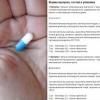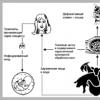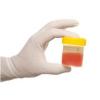Analysis for toxoplasmosis during pregnancy. Deciphering the analysis: what are the antibodies to the pathogen. Questions Toxoplasmosis deciphering the results by numbers
It is for antibodies of various classes to toxoplasma that there are certain reference indicators that can be conditionally called norms. These concentrations of antibodies to toxoplasma make it possible to determine their presence or absence in a person’s blood, and then, based on the decoding of the tests, find out if the person had toxoplasmosis and how long ago he had this infection.
Currently, the concentrations of the following types of antibodies to toxoplasma are determined:
After determining the amount of antibodies in the blood, an analysis result is issued, which can be of three varieties - positive, negative or questionable. A positive result means that the person has antibodies in their blood. A negative result means that the person has no antibodies in their blood. And a dubious result does not allow you to say for sure whether there are antibodies in the blood or not. For clarification, it is necessary to retake the analysis again in 2 to 4 weeks.The conclusion about a positive or negative result is made on the basis of the standards adopted in each particular laboratory. The standards of laboratories depend on which set of reagents is used to determine the concentration of antibodies. For example, the following standards are adopted in the Synevo laboratories:
1. IgG - less than 9.0 - a negative result, and more than 12 - a positive result;
2. IgM - less than 0.8 - a negative result, and more than 1.1 - a positive result.
A positive IgM result indicates that the person is currently suffering from toxoplasmosis. A positive IgG result indicates that a person has had toxoplasmosis in the past and is now immune against reinfection. The presence of IgG antibodies is a kind of norm, since it indicates that a person has already had an infection once and will never get it again. Therefore, if a pregnant woman has IgG antibodies in her blood, she should be happy, not upset, because this means that she will never be able to get toxoplasmosis. Moreover, its antibodies will pass through the placenta to the baby, who will also be protected from toxoplasmosis during the first 6 to 12 months of life. If antibodies of the IgG class are not found in the blood of a person, this means that he has never had toxoplasmosis and may become infected in the future.
How does infection occur?
Pathogenic microorganisms enter the human gastrointestinal tract in the following ways:
- close contact with pets;
- eating poorly washed vegetables and fruits;
- non-compliance with the rules of hand hygiene.

Ways of infection with Giardia
Signs of toxoplasmosis
With a weakened immune system and extensive damage by toxoplasma, a person may experience the following signs of infection:
- frequent headaches;
- weakness and fatigue;
- feeling sleepy;
- increase in body temperature;
- enlargement of the lymph nodes.
If all of the above symptoms are detected, it is recommended to be tested for toxoplasmosis.
Diagnosis of the disease
The following types of tests for toxoplasmosis are considered the most effective modern methods of diagnosing:
- enzyme immunoassay (ELISA);
- polymerase chain reaction (PCR).

Enzyme immunoassay (ELISA) and polymerase chain reaction (PCR) are done for toxoplasmosis
Since it does not take much time to take an analysis for Toxoplasma and it can be done in any laboratory where blood is taken from a vein, it is recommended that everyone who cares about their health, especially women of reproductive age, undergo an examination.
Key points and rules on how to get tested for toxoplasmosis:
- 12 hours before delivery, exclude fried and fatty foods from the diet;
- the test is performed on venous blood;
- analysis is given in the morning on an empty stomach.
Compliance with the above conditions will allow you to get more reliable results.
After passing it, many are very interested in deciphering the analysis for toxoplasmosis even before visiting the attending physician.
Immunoenzymatic type of blood tests are one of the most reliable types of tests. But when receiving analyzes, a thorough interpretation of the results is required.
The collected material is examined for the presence of antibodies or immunoglobulins to Toxoplasma. They are divided into two types - early and late.
Early (IgM) express a severe course of the disease, and their presence indicates that the infection has occurred very recently (no later than two months ago).
Late antibodies () appear a few days after infection and remain in the body for life.
What do research data mean?
It is not so difficult to decipher the given enzyme immunoassay, knowing what the symbols indicated in the form mean. In addition, as a result of the analysis, the norm is always indicated.

Results interpretation table
With an enzyme immunoassay for toxoplasmosis, the decoding of the results is as follows:
- IgM (-) IgG (-) - the norm, indicating that a person has never been infected with Toxoplasma. But a pregnant woman with such indicators automatically falls into the risk group, and she should be tested for toxoplasmosis every trimester.
- IgM (-) IgG (+) - these indicators indicate that the body reacts to toxoplasmosis as a chronic disease, to which a person may have developed a persistent immune response. The numbers of avidity will help to understand this. The norm for stable immunity is 60 or more. Indicators below this should alert a woman if she is already in position.
- IgM (+) IgG (-) - such results indicate that toxoplasmosis in humans occurs in an acute form. This condition is dangerous for the fetus if a woman is waiting for the baby to appear.
- IgM (+) IgG (+) - indicators that indicate either primary infection or a period of remission. With avidity of 40 or less, the presence of primary infection should be assumed. Values from 41 to 59 are transitional and do not give a clear picture, so you will need a second blood test after a couple of weeks. If the avidity is 60 or higher, then we can talk about the recovery period.
The most accurate data can be obtained today only with the help of PCR. With toxoplasmosis, decoding analyzes of this type is quite simple.
The norm in this case is a negative result. With positive indicators, it should be understood that the course of the disease takes place in an acute form.
What to do with positive results?
Fansidar is one of the most effective drugs used in the treatment of toxoplasmosis. Contraindications to its use are a period of pregnancy up to three months, small patients under two months of age, as well as renal or hepatic insufficiency. The dosage of the drug depends on the course of the disease, the age category to which the patient belongs, and the patient's body weight. Before taking the medicine, it is recommended to study the instructions well, because Fansidar is not compatible with all medicines.
"Pyrimethamine" is also considered one of the most effective in acute toxoplasmosis. The dosage of the drug is prescribed by the doctor, or determined using the instructions. Treatment is carried out in two or three courses, depending on the severity of the disease. One course can last from a week to ten days. After the treatment period, an interval of ten days is made, then the therapy is repeated. The drug has the same contraindications as Fansidar.
Also during this period, antibacterial medicines such as Spiromycin, Rovamycin and Clarithromycin. Of all these drugs, Rovamycin is considered the most effective, which is also one of the safest used during pregnancy. It has a wide spectrum of activity and can be used for various infections. The only contraindications for use are liver failure and obstruction of the bile ducts. The dosage and period of antibiotic treatment is strictly determined by the doctor.
An alternative to conservative treatment is chemotherapy, which is more effective than oral medications.
People who have never had toxoplasmosis or who have had successful chemotherapy should adhere to the following prevention rules:
- limiting close contact with pets;
- washing hands after each contact with foreign objects;
- processing vegetables and fruits with soap and water.
A disease that does not at first glance pose a threat to a person can become dangerous, affecting the body of a woman who is expecting a child. Being aware of how the disease occurs, its course, and being tested for toxoplasmosis will help you avoid unnecessary fears and worries and take steps to protect yourself.
Toxplasmosis belongs to a group of infections that are transmitted directly from mother to child. In a different state, people do not transmit the infection. The presence of an infection in a woman's body can cause miscarriage and severe malformations in a newborn baby.
Description of the disease
Usually, infection and disease with toxoplasmosis occurs without obvious symptoms and does not cause concern to the patient. After that, the person develops immunity and re-infection is not observed.
But if two factors coincide:
- the body encounters an infection for the first time;
- woman expecting a baby
toxoplasmosis leads to serious consequences. Of particular danger is infection for the intrauterine development of the fetus.
A person can become infected with toxoplasmosis:
- from infected domestic cats;
- when eating the meat of infected domestic animals or greens that have not been cooked. Toxoplasma dies when products are heated to 40 degrees C;
- when transplanting organs or transfusing blood from sick donors;
- from mother to child.
Whether the disease manifests itself or the body's defenses are enough to destroy the infection depends on many factors. Even if the disease can develop, a person may not notice its symptoms, but find out about it only after passing the examination.
Symptoms of toxoplasmosis are similar to those of SARS:
- the temperature rises;
- enlarged lymph nodes in the neck and neck;
- there is sweating and general weakness.
Normally, this condition lasts a week.
In a weakened body, Toxoplasma, without encountering resistance, is carried throughout the body by blood and lymph flow, infecting the central nervous system, eyes, and heart. In severe cases, debilitated patients develop encephalitis with headache attacks, convulsions, and fainting.
After the illness, the body forms immunity and re-infection does not occur.
Features of diseases in pregnant women
Infection of a pregnant woman who has not previously suffered from toxoplasmosis is the only danger of infection. The chance of infection - 1 lady out of 100 - in the first three months, strong placental protection will not allow toxoplasma to penetrate. Infection of a pregnant woman does not mean 100% infection of the child.
The dependency is the following:
- with a short period, there is a small possibility of infection, but the consequences are more severe while maintaining pregnancy;
- the longer the period of pregnancy, the greater the possibility of damage to the fetus and the easier the consequences of the disease.
In the short term, infection can pass without consequences for the fetus, or the resulting pathologies will lead to its death.
Due to infection after the 20th week of pregnancy, massive fetal malformations may develop. Very often, doctors recommend an abortion if the infection appears before the 20th week of pregnancy.
When a newborn with a congenital disease appears, there will be:
- small rash;
- microcephaly;
- jaundice;
- hydrocephalus.
If the disease is detected in a timely manner and treated, the consequences can be minimized. If a lady has had toxoplasmosis before, neither she nor the fetus is in danger. To assess the risk of the disease in pregnant women, tests for toxoplasmosis are carried out.
Indications for the study
You need to be tested for toxoplasmosis when:
- pregnancy planning;
- planned examination of pregnancy;
- swollen lymph nodes of unknown etiology, if no previous analysis was performed;
- detection of human immunodeficiency virus and other similar conditions;
- enlargement of the liver and spleen of unknown nature;
- possibility of fetal infection.
To determine the disease, there are only two types of analytical studies:
- enzyme immunoassay (ELISA);
- polymerase reaction method (PCR diagnostics).
The first is based on a blood test for toxoplasmosis to determine the presence of specific antibodies.
The second method is based on the search for the DNA of the causative agent of the disease in the blood of a person.
When conducting an enzyme immunoassay, specific proteins are isolated from the patient's blood, which are produced by the body when an infection enters the blood. These are M (IgM) and G (IgG) proteins.
Proteins of the first group (M) appear in the body from the first days to 3 weeks after the onset of the disease. After this period, their traces in the body disappear. If the analysis for these proteins is positive, and group M immunoglobulins are found in the blood, then this can be interpreted as confirmation of the presence of the causative agent of toxoplasmosis and the disease in an acute form.
Protein G (IgG) appears in the blood on the third day after infection, and its amount in the blood increases in response to the infectious invasion.
Antibodies of this group remain in the blood until the end of life, creating a shield against secondary disease.
If immunoglobulins of this group are found, then:
- infection with toxoplasmosis was a long time ago;
- it is possible to infect an organism that has not previously encountered this infection and additional tests are required.
It is possible to carry out PCR - diagnosis of toxoplasmosis. This analysis has excellent sensitivity and reliability. Now increasingly use this method to determine the infection of the body. It should be given at the first symptoms of the disease.
How to prepare for the analysis
How to pass the analysis so that the result is correct? When prescribing a study for toxoplasmosis, as well as for a regular analysis, you do not need to follow any special recommendations. Since venous blood is taken, the general rules for such a procedure will be effective - the rejection of antibiotics 14 days before the analysis.
Three days before the analysis, you need to give up fatty and spicy foods, alcohol, strong tea and coffee. On the day of the analysis, strong-smelling perfumes should be excluded.
How to read the analysis
Deciphering the analysis for toxoplasmosis is possible only by a doctor.
Possible interpretation of the ELISA analysis:
- the given analysis for toxoplasmosis does not contain immunoglobulins IgG, IgM - there is no pathogen in the blood. But this combination indicates a complete lack of immune protection, a person is at risk of illness. With this combination, pregnant women should do tests in each trimester of pregnancy;
- IgG +, IgM - confirms a strong immunity in humans to toxoplasma;
- IgG -, IgM + signals an acute reaction to toxoplasma in a woman's body. The risk of fetal damage in pregnant women is very high;
- IgG -, IgM - with this combination of globulins there is a danger of primary infection. For a clarifying analysis, a polymerase chain reaction analysis is necessarily used.
When conducting a PCR analysis, a positive response means the presence of an infectious agent in the body, a negative one means the absence.
The transcript of the results contains indicators of avidity.
In contact with
According to statistics, every third inhabitant of our country is infected with toxoplasmosis. Often, carriers of the disease do not even know about their condition, since the infection may not manifest itself in any way - the person does not have any pronounced symptoms. Due to the uncomplicated and often asymptomatic transmission of this disease, insufficient attention is paid to diagnosis and treatment methods. While in some cases, infection can lead to fatal consequences and serious complications. What does it mean if toxoplasmosis is found in the blood? The norm and deviations of indicators, how immunoglobulins of the IgG and IgM groups contribute to the diagnosis of infection, and how the disease can be managed and prevented, is described in this article.
The body's response to infection with toxoplasmosis
As with any other infection, the human body reacts to infection with toxoplasmosis by activating the immune defenses. Namely, the production of special antibodies, immunoglobulins of the protein groups IgG and IgM.

It is worth considering in more detail the functions and properties performed by immunoglobulins of the IgG group in the body when infected with a disease such as toxoplasmosis. The IgG norm is an ambiguous concept. The presence of immunoglobulins of this group can indicate both the acute phase of the disease and a long process. How do antibodies fight disease? They perform a number of functions that protect the body and adversely affect the viability of the pathogen, namely:
Interesting and important is the fact that it is the immunoglobulin of the IgG group that makes up 80% of all immunoglobulins in the body. In addition, in chronic forms of infections and autoimmune diseases, the percentage of IgG immunoglobulins increases.
Deciphering the indicators of immunoglobulin IgG
Usually, a study is not done on the quantitative measurement of immunoglobulins in the analysis for toxoplasmosis. The norm in the blood is an indicator of the detection or absence of immunoglobulins. Most often, in the results of the analysis, such designations as “positive” or “negative” are noted. But in some cases, according to indications, the doctor may prescribe a special quantitative analysis. It is rather difficult to give specific norms for IgG immunoglobulin indicators, since each laboratory has its own criteria. Such differences are due to the use of different chemicals during the analysis for toxoplasmosis in the blood. The norm differs markedly depending on the laboratory. As an example, the following indicators can be cited:
- How to decipher the results of the analysis for toxoplasmosis? Normal IgG is below 700 mg/dl. A positive result of the analysis for measuring the amount of immunoglobulins of the IgG group is 700-1600 mg / dl or 7-16 g / l. Indicators below the specified limits are considered a negative result.
- Using other units of measurement, the following norms of IgG immunoglobulin parameters are indicated: above 12 U / ml is considered a positive result, below 9 U / ml - negative, indicators between the indicated norms are doubtful and require additional research.
Regardless of how the indicators are labeled, they have the same meaning. Tested positive for toxoplasmosis in the blood? The norm is the presence of IgG antibodies and the absence of IgM. The presence of IgG immunoglobulins in the test material indicates that the organism met with the causative agent of toxoplasmosis. This means that a person is reliably protected from secondary infection. But at the same time, such results may indicate a primary recent infection. To confirm or refute this assumption, it is necessary to analyze the parameters of IgM immunoglobulins, which appear in the body only during the acute phase of the disease. Accordingly, the presence of such antibodies indicates a primary infection and a serious danger to the fetus. In such a situation, the doctor diagnoses "toxoplasmosis". The norm in the blood is the absence of antibodies of the IgM group. Such indicators indicate a long-term infection and the absence of any danger to the body.

If the results of the analysis indicate the absence of IgG immunoglobulins in the body, special measures should be taken to prevent infection during pregnancy, since such results indicate the absence of protective antibodies against toxoplasmosis.
Methods for diagnosing toxoplasmosis
There are the following types of diagnosis of toxoplasmosis:

Method for diagnosing toxoplasmosis ELISA
More often than others, it is used to determine toxoplasmosis. It is this method that allows you to determine the duration of infection, to establish the acute phase of the disease. Such indicators can be distinguished due to the detection of IgM immunoglobulins. If the form says: "toxoplasmosis: normal in the blood," the result means that there is no acute phase of the disease.
The decoding is standard and has no features when analyzing during pregnancy. Let us consider in more detail what the results mean: "acute phase of the disease" and "toxoplasmosis: normal in the blood." The table provided below clearly demonstrates the indicators and their designation. Namely:
| Immunoglobulin IgM | Immunoglobulin IgG | Characteristics of indicators |
| - | - | Special attention should be paid to preventive measures. Such results indicate the absence of protective antibodies in the human body. |
| - | + | The result indicates a long-term infection that does not pose a danger to the body. In addition, a person is protected from re-infection with toxoplasmosis. |
| + | - | This option is the most unfavorable. It indicates a primary infection that occurred less than 5 days ago. |
| + | + | It is also a negative result, as it indicates infection no later than a month ago. |
Toxoplasmosis: the norm in the blood during pregnancy
Infection in the later stages leads to premature birth, stillbirth, the appearance of a child with serious developmental pathologies, such as:
- inflammation of the retina, blindness;
- deafness;
- enlargement of the spleen and liver;
- violation of the development of internal organs;
- jaundice;
- damage to the central nervous system (convulsions, paralysis, hydrocephalus, oligophrenia, epilepsy, encephalitis);
- pneumonia;
- disruption of the heart;
- external deformities: splitting of the lips and palate, developmental pathologies of the limbs, hernia, hermaphroditism, strabismus, cataracts and more.
Many of the above congenital pathologies lead to infant mortality during the first few weeks of life or to profound disability. There are cases of the birth of a child without pronounced, at first glance, pathologies. But during the first year of life, symptoms of acute toxoplasmosis appear.

Considering the high level of infection risk for an unborn baby, doctors during the planning period, conception, and throughout pregnancy prescribe a comprehensive analysis for TORCH infection to women, which includes a test for toxoplasmosis. The norm of tests during pregnancy is no different from generally accepted indicators.
Timely treatment significantly increases the chances of having a healthy baby. In this case, the benefits of the drugs used outweigh the possible harm caused by them.
Indications for the treatment of toxoplasmosis
The result of “toxoplasmosis: the norm in the blood” is indicated on the analysis form - treatment in this case is not required. In most cases, the human immune system is able to cope with a pathogenic microorganism on its own. Treatment is prescribed only for various disorders of immunity in the following cases:
- in acute toxoplasmosis in order to prevent serious complications in AIDS patients and pregnant women;
- in the chronic form of the disease during the period of exacerbation in order to form a normal immune response;
- treatment can be prescribed for chronic toxoplasmosis in case of development of chorioretinitis, infertility, miscarriage.
Treatment of toxoplasmosis in immunocompromised people who are not pregnant
People with a weakened immune system may be prescribed different drugs, depending on the symptoms and history:

Pregnant women are not allowed to take these drugs.
Treatment of toxoplasmosis in pregnant women
If the analysis confirms the presence of an acute phase of infection, one of two types of therapy can be used:
- The appointment of "Rovamycin" is possible in various courses: 1.5 million units twice a day for 6 weeks; 3 million units twice a day for 4 weeks or 3 million units three times a day for 10 days. Assign such treatment for a period not earlier than 16 weeks of pregnancy.
- A complex consisting of Pyrimethamine and Sulfodaxin. The dosage and duration of the course is indicated by the doctor. Treatment can be prescribed after 20 weeks of pregnancy.
- With inflammation of the eyes, treatment with "Prednisolone" is necessary.
- Also in uncomplicated cases, Spiramycin is used.
Prevention methods
If you are planning a baby, and the results of the tests showed the absence of antibodies to toxoplasmosis, there is no other way to protect the unborn baby from the disease, except for preventive measures. Based on knowledge about the methods of infection, the following preventive measures can be identified:
- minimize contact with animals throughout the entire period of pregnancy;
- do not eat raw and poorly fried meat, unwashed vegetables;
- work with soil only in;
- Remember to wash your hands thoroughly and often.

Based on the information presented in the article, we can conclude that toxoplasmosis is an extremely dangerous disease for a future mother and her baby. But modern medicine is able to timely detect specific antibodies that protect the body from infection. In this case, it is necessary not only to pass on time, but also to correctly interpret the results of the analysis for toxoplasmosis. The norm in pregnant women is no different from generally established indicators. Thus, the presence or absence of IgG immunoglobulins may indicate directly opposite clinical pictures. Therefore, trust the specialist - strictly follow all his recommendations, do not decipher the results yourself. In this case, the probability of a successful birth of a healthy child is very high. Be healthy!
Symptoms of toxoplasmosis
 If toxoplasmosis is acquired, then the disease is asymptomatic or with minimal clinical signs from mild forms to generalization of the process, or acquires a primary chronic course. The incubation period is usually within 3 weeks. In the acute course of the disease, body temperature rises to 38-39 ° C, weakness, severe headache, muscle and joint pain, and weight loss appear. Perhaps the appearance of a maculopapular rash, which merges, spreads over the entire surface of the body, with the exception, however, of the palms and soles. Typical signs are enlargement of the liver and spleen, regional lymph nodes, which are painful to the touch. In generalized forms, there are, among other things, myocarditis with cardiac arrhythmias and signs of heart failure, changes in the central nervous system in the form of encephalitis or meningitis, or a combination of both. Acquired toxoplasmosis in the vast majority ends with convalescence or less often acquires a chronic course, which is characterized mainly by signs of prolonged intoxication and asthenovegetative syndrome.
If toxoplasmosis is acquired, then the disease is asymptomatic or with minimal clinical signs from mild forms to generalization of the process, or acquires a primary chronic course. The incubation period is usually within 3 weeks. In the acute course of the disease, body temperature rises to 38-39 ° C, weakness, severe headache, muscle and joint pain, and weight loss appear. Perhaps the appearance of a maculopapular rash, which merges, spreads over the entire surface of the body, with the exception, however, of the palms and soles. Typical signs are enlargement of the liver and spleen, regional lymph nodes, which are painful to the touch. In generalized forms, there are, among other things, myocarditis with cardiac arrhythmias and signs of heart failure, changes in the central nervous system in the form of encephalitis or meningitis, or a combination of both. Acquired toxoplasmosis in the vast majority ends with convalescence or less often acquires a chronic course, which is characterized mainly by signs of prolonged intoxication and asthenovegetative syndrome.
For congenital toxoplasmosis in newborns infected in the first trimester of pregnancy, the classic triad of hydrocephalus, chorioretinitis and intracranial calcifications is characteristic, as well as jaundice, pneumonia, or a clinical picture of sepsis. Newborns infected at the end of pregnancy usually have no clinical signs of the disease at birth.
Diagnosis of toxoplasmosis
The diagnosis is based on a thorough history taking, clinical symptoms and the results of serological tests (ELISA, PCR), as well as an additional examination confirming organ damage (ECG, EEG, skull X-ray, CT), consultations of an ophthalmologist, cardiologist and neurologist.
Differential diagnosis is carried out with lymphogranulomatosis, tuberculosis, rheumatism, infectious mononucleosis and herpetic infection.
Treatment of toxoplasmosis
Essential drugs
There are contraindications. Specialist consultation is required.


- Pyrimethamine (an antiprotozoal). Dosage regimen: inside, 0.1-0.2 g per day in 2 doses for 2 days, then 0.025 g inside 1 time per day for 4-5 weeks.
- Sulfadiazine (antimicrobial agent). Dosage regimen: inside, 4-6 g per day in 4 divided doses for 4-5 weeks.
- Spiramycin (antibacterial agent). Dosage regimen: inside 1 g (3,000,000 IU) 3 times a day for 2-3 weeks.
- (antibacterial agent). Dosage regimen: inside, 0.45 g 3 times a day or 0.6 g intravenously 4 times a day. IV infusions are prescribed only for adults.



















